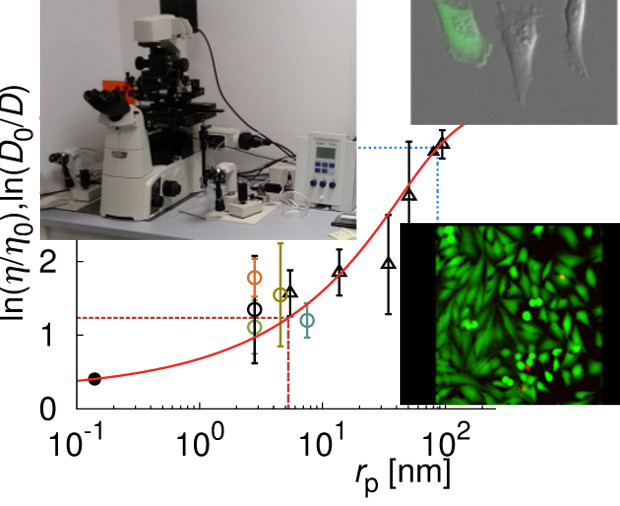
We have developed the phenomenological model of length-scale dependent viscosity of complex liquids (nanoviscosity).
The model applies to motion of nanoprobes in polymers, micellar solutions, hard-sphere and protein solutions.
In the model the viscosity experienced by the nanometric probe in motion (either directed or diffusive) is related to three length-scales:
i) length-scale corresponding to size of the crowding agents,
ii) the correlation length,
iii) the length-scale related to the hydrodynamic flow around the probe.
The last length-scale is comparable to the size of the probe.
The concept of the length-scale dependent viscosity was also successfully addressed in eukaryotic cells.
It was tested inside of the cytoplasm of two eukaryotic cell lines: HeLa (human cervical cancer) and mouse fibroblasts.
Probes of given size, which included fluorescent or fluorescently labeled dextrans, proteins and dyes, were introduced by means of microinjection.
This approach allowed precise and efficient introduction of probes into live cells.
Measurements of relative viscosity were performed by fluorescence correlation spectroscopy and confronted with existing model.
The model was also successfully applied to describe diffusion in prokaryotic cells. For further information please read:
Holyst R., et al., Phys. Chem. Chem. Phys., 2009, 11, 9025-9032; Ziebacz N., et al., Soft Matter, 2011, 7, 7181-7186;
Kalwarczyk T., et al., Nano Lett., 2011, 11 (5), pp 2157-2163; Kalwarczyk T., et al., Bioinformatics, 2012 28(22): 2971-2978;
Tabaka M., et al. Soft Matter, 2013, 9, 4386-4389; Sozanski K., et al. Phys. Rev. Lett., 2013 111, 228301;
Tabaka M., et al. Nucl. Acids Res. 2014 42 (2): 727-738; Kalwarczyk T., et al. Nanoscale, 2014, 6, 10340-10346;
Wisniewska A., et al., Polymer 2014 55 (18), 4651–4657; Tabaka M., et al., Front. Phys., 2014 DOI: dx.doi.org/10.3389/fphy.2014.00054;
Kalwarczyk T., et al., Advances in Colloid and Interface Science, 2015 223, 55–63;